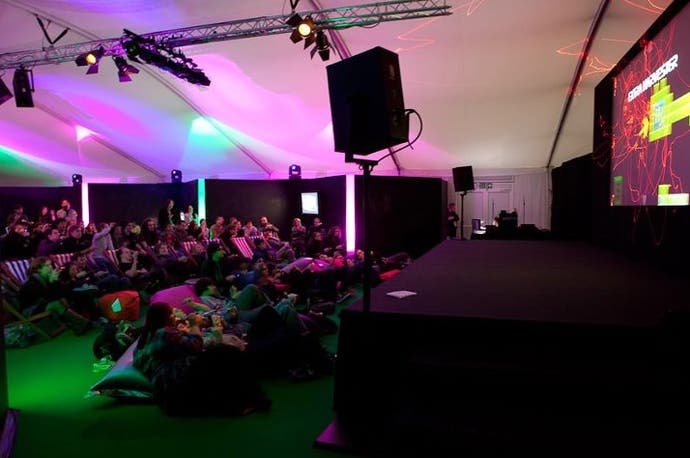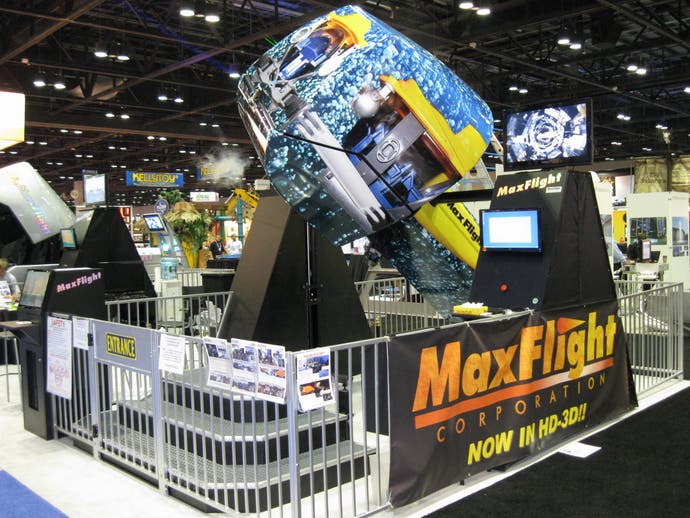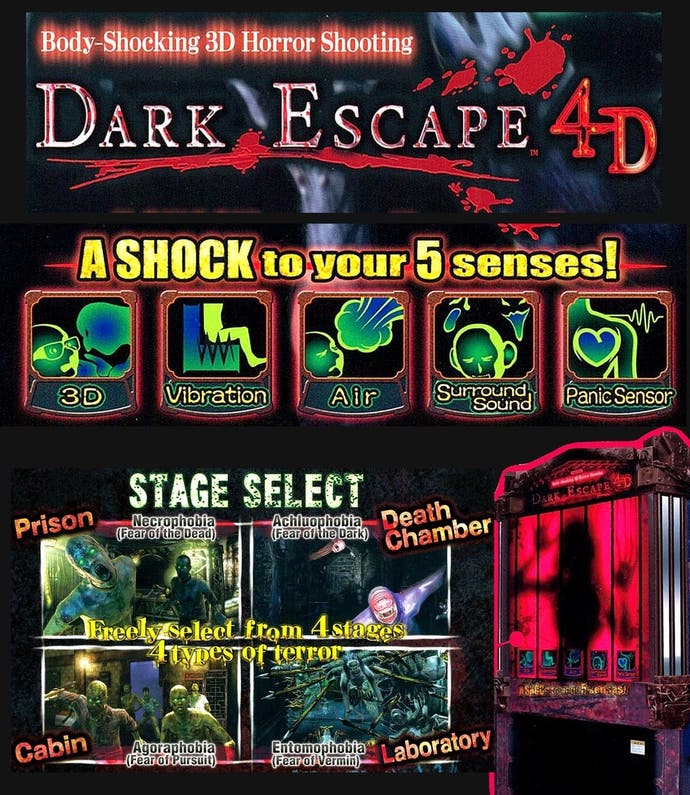Step inside the arcade of the future
The coin-op is dead, long live the coin-op.
There once was a time when if you wanted to sample the most exciting and thrilling games, you had to leave the comfort of your sofa and venture to the nearest smoky amusement arcade, where you would rub shoulders with other like-minded players and watch slack-jawed as the local Street Fighter 2 expert took on all challengers, or gasp in amazement at the lush 3D visuals showcased by Virtua Racing, Daytona USA and Ridge Racer. These days, the closest most people get to a traditional arcade gaming experience is the battered Sega Rally and Time Crisis cabinets which sit awkwardly in the local bowling alley - their 3D prowess now looking considerably muted compared to the latest iOS titles you can carry around in your trouser pocket.

So what happened? How did this vibrant social scene die out?
The perfect person to answer this question is Kevin Williams. Williams has done it all when it comes to the "Digital Out-of-Home" entertainment industry - a fancy term for any form of interactive location-based entertainment which takes place outside the living room. He worked on Virtual Reality before it became the buzzword of the early '90s, and has collaborated and consulted with companies such as Sega, Disney and Infogrames. He is the founder of the DNA Association, which runs the DNA Conference - the Digital Out-of-Home Interactive Entertainment sector's leading showcase event, held in London in 2011 and in California last year.
He feels that the start of the rot for traditional arcade gaming was connected with the desire of manufacturers to dazzle and entice players away from their home hardware. "The drive towards specialist architecture that could create revolutionary graphics turned into an arms race between the amusement factories," he explains. "This conflict decimated research and development reserves and at the same time engendered a perception of specialist architecture being the only way. To avoid vast expenditure, Sony worked with Namco and from the resulting System 22 hardware we would see not only Ridge Racer but also System 11, which would ultimately be the PlayStation console in coin-op clothing. The rest of the arcade factories could not establish this kind of 'Remora' relationship with the emerging console scene, so console gaming took the lead in technological advancement. Inevitably, the arcade makers lost the lead as their available investment in new R&D - the lifeblood of amusement - dried up. By the time these companies realised they would have to adopt an approach seen with PC hardware, it was too late for many."
In short, home console titles became so impressive that they effectively rendered arcade gaming irrelevant. However, just as cinema survived the arrival of VHS and DVD formats, Williams feels that the amusement sector is already starting to bounce back - and is currently playing host to some of the most exciting and immersive experiences available. However, he notes that this rebirth is happening largely under the radar of most gamers - and the media channels which report to them.
"The traditional arcade venue was decimated by innovation, but the video amusement trade has continued to develop and innovate," he says. "I'm talking about machines such as those in bowling, cinema, family and adult entertainment centers, and a hoard of other venues. It would be best to say that the consumer game media that reported in the heyday about new arcade games in the hope that they would be ported to consumer platforms has all but abandoned coverage as console gaming has proven itself to be a much larger and more vibrant industry. Now that console gaming is at a defining point in its history, Digital Out-of-Home amusement is gaining traction... moving beyond the traditional perception of the arcade coin-op game, looking to a marriage of theme park attraction technology in a package that can be deployed in a variety of facilities."

This intriguing fusion is starting to pay dividends. Just as moviegoers have begun to embrace cinemas again after temporarily abandoning them in favour of domestic flicks, Williams feels that gamers are starting to change their attitudes about location-based entertainment experiences, and are once more warming to the notion of playing games beyond the comfort of their living rooms.
"One aspect about the transition to a new generation of consoles is the spending power of the audience on the distraction of gaming," he says. "Many are looking to leave their homes for social entertainment rather than spend increasing sums on games and consoles that offer no major sea-changes in quality. That the amusement sector is able to update its technology with every new release is now a benefit that is hard for the console scene to compete with. The amusement sector is already fielding 1080p graphics, auto-stereographic displays, the latest high-end rendering engines and even augmented-reality displays." Ironically, the situation appears to have come full-circle - amusement arcades are once again able to offer distinct technological advances over domestic systems.
The social gaming explosion - recently popularised in the home environment by the Nintendo Wii - is driving Digital Out-of-Home gaming in a big way, too. "The experience is entirely social," says Williams. "The ability to compete with your peers has been a driving force in the amusement experience since the high score was invented. For Nintendo, 'tapping into' the social experience is defined by four players squeezed round a television. In the Digital Out-of-Home sector, the rise of social entertainment has seen interactive gaming systems deployed wherever crowds gather, including a big push in the hospitality sector.
"Then there's 'Hybrid Entertainment', the utilization of Digital Out-of-Home technology in new areas of business including deployment with mixed reality games and alternative reality games. In this area we have wallFour, which is a great exponent of the use of gamification within a social environment. We were lucky enough to have them demonstrate at the recent DNA Association conference in Los Angeles last year, and the compelling nature of the game - which encourages the audience of a hundred players working together at a time - is highly enjoyable and unlike any consumer alternative. Another new start-up in this sector is Hide&Seek and their innovative Kinect-based Searchlight game, which sees players moving physical items to avoid being caught in the virtual searchlight."
These social gaming experiences - where an entire roomful of people can participate - are now trickling into other sectors and finding a highly receptive audience to boot. "The ability for the game to be an audience entertainment tool is not lost on the hospitality sector, and the retail industry with the largest developments in this sector is bars and clubs," says Williams. "It is fascinating to see that not only the latest mixed reality technology but even the traditional amusement technology is finding a home in the new hospitality scene. What have been called 'Gamebars' are becoming one of the fastest start-up businesses in the States; bars and taverns that mix classic arcade cabinets in a brew pub atmosphere. Facilities have opened across America that offer an arcade player's paradise with a highly social environment. The legal drinking age in America, linked to a maturing of the game playing audience, has created a perfect combination for arcade gaming to receive a second revolution."
Emerging tech is combining with this social environment to create some truly incredible experiences. "The highly social nature of the entertainment experience seems to have grown as new approaches to the immersive entertainment experience have been applied," says Williams. "The technology of networked simulator experiences is highly exciting, and surprisingly being fuelled by investment from the consumer game scene. The popularity of Sim-Racing has migrated from the restrictions of a home PC rig, and now simulation centers are opening, deploying advance racing cockpits and immersive display systems - such as RaceRoom Entertainment and the TL1 concept from Motion Simulation."

Again, it feels like a case of history repeating itself. Just as with Sega's After Burner and G-LOC - which both boasted unique hydraulic cabinets that supplied a gameplay experience which was simply impossible to replicate at home - we're seeing manufacturers become ever more inventive and resourceful when it comes to crafting the next-generation coin-op ride. "The latest developments in motion platforms have seen a number of great game platforms to be deployed into the market," explains Williams. "From the ultra-realistic F1-style driver simulator from Cruden to the intense 360-degree axis motion capsule flight simulator platform from Maxflight, the ability to add intense motion simulation to a game experience offers a level of excitement that takes gaming to a new level. With these compelling advance entertainment simulators we also have the immersive audience experiences - systems such as Triotech's XD Dark Ride theatre - offering eight players the chance to compete in an interactive big screen game experience like no other. The system is extremely compelling, with 3D images, motion seats and other physical effects. We're also seeing new 'Mixed Reality' applications in this sector that are also highly exciting."
While such technology is undeniably interesting, it's not wholly innovative - the aforementioned Sega arcade classics were pulling this kind of "motion gaming" trick decades ago, albeit with less impressive on-screen visuals. However, there are products emerging now which are genuinely groundbreaking, and unlikely to be replicated in your living room any time soon. "Recently in the amusement scene we've seen companies such as Creative Works and its Lazer Frenzy laser maze attraction that offers a highly physical gaming environment," reveals Williams. "Other developers are looking at immersive projection enclosures that the player enters and interacts with. This level of technology supersedes anything that could be achieved within the restrictions of the player's home, but also deploys mixed reality technology that will not be available in time to be bolted onto the next generation of consoles."
Many of the firms operating in this sector won't be instantly familiar to traditional gamers, but what of the old guard? Back in the '80s and '90s, it was companies like Sega, Konami, Namco and Irem who dominated the amusement landscape. Are any of these old veterans still working in the industry today, and who is producing the most captivating stuff? Furthermore, are they making any cash out of it?
"Following its merger with Sammy, Sega has undertaken a major restructuring and has already seen fruit from this - the company's amusement sales and facility operation business is one of the few profitable aspects of its portfolio," replies Williams. "The company's bedrock is an element which drives all the remaining amusement factories - that of connectivity. The ability to network the machines offers players their own unique profile with stored characters and scores, and the ability to challenge and compete in competitions. This is driving innovation far beyond the online delivery services on home console systems. Sega's ALL.Net architecture offers a high level of competition - so much so that its has partnered with Namco to deploy the system across their own releases." Sega's most recent arcade title is a motion-based two-player shooting release called Dream Raiders.
Namco - now fused with former rival Bandai - also continues to operate in the amusement sector, with more success than you might imagine. "Following its merger with Bandai, Namco has also restructured its approach and has reinvested in its amusement business," explains Williams. "The game Dark Escape is a unique two-player horror shooting experience that monitors the each player's heart rate, puffs gusts of air and moves their seats and represents the game in stereographic graphics."
Ironically, Virtual Reality - a tech which endured a baptism of fire in the early '90s and failed to convince both arcade and domestic players of its worth - is also undergoing something of a renaissance thanks to products such as Oculus Rift. Given his history with the tech, Williams is the ideal person to pass comment on its chances, and where it fits into the out-of-home sector.
"I am fascinated to see Virtual Reality back on the lips of the gaming industry," he admits. "I have worked in and followed the application of virtual entertainment environments from simulation, Virtual Reality and immersive displays, so following the faltering steps of Oculus has been fascinating and I wish them the best of luck in visualizing their dream. However, not many people will be aware that some of the first applications that propose to use the final 'Oculus Rift' platform are not home games, but Digital Out-of-Home releases. Virtual Reality - originally championed in the amusement scene - is making a return as a deployable attraction package. Companies such as Mocap Games are launching a Virtual Reality Head Mounted Display game platform which also uses gesture recognition so the player's movements are represented in the virtual world. Virtual Reality is an easier technology to see in an out-of-home setting due to expense and complexity of experience - though home applications are close behind, the out-of-home application has its own benefits."

It seems almost ironic that, just as arcade and Digital Out-of-Home experiences are starting to become relevant again, the console industry finds itself in a curious position. Nintendo's Wii U has proved to be something of a commercial disappointment thus far, and the many industry analysts are daring to predict that it - along with the PlayStation 4 and Next Xbox - could represent the final generation of traditional console hardware. Williams believes that the industry is about to hit a period of extreme transition, and emerge from a pattern which was brought about almost three decades ago.
"I originate from the early days of the personal computer game scene that was basically hijacked by Atari and Nintendo towards creating a locked-in platform where players were forced to support an architecture that was unchangeable," he says. "This bullying of the audience to not only support a platform - but also pay whatever price to buy games only for that platform - seems to have foundered on the greed of the manufacturers. When they provided innovative technology with compelling game content the audience sat on their frustrations, but now, with a never-ending supply of formulaic and repetitive genres titles, the audience is wavering. The success of DayZ is a great example of better-than-console play from the PC sector placing a magnifying glass on the reality of gaming; for too long the media has perceived consoles as the only purveyors of gaming."
"As we saw in the last boom in the 1980s - where the end of the Cold War saw simulation technology from the military sector invading the consumer scene - we see another influx of previously restricted and prohibitive technology break into the commercial entertainment sector" - Kevin Williams
The entire interactive entertainment sector feels like it is entering a time of great upheaval, with mobile platforms like iOS and Android creating new ways to play and proving that massive budgets and dazzling visuals aren't strictly necessary to capture the attention of consumers. It's also noteworthy that free-to-play mechanics and micro-transactions are gathering speed - two elements which owe a significant debt to the coin-op scene, with its never-ending demands on players to insert more cash to keep the experience going.
Where does the arcade of the future lie within this slightly chaotic maelstrom? And what developments can drive location-based entertainment forwards? "From the perspective of the out-of-home approach, our future lies in the hands of the players," admits Williams. "It would be best to say that a change in the way players play - and where they play - could totally shift the draw of compelling entertainment from the couch and to the club. With a maturing audience that expects to be wowed by their game technology, it is expected that the latest 3D projection systems can offer the biggest bang for the buck in a Digital Out-of-Home application. Along with the developments seen with 3D Projection Mapping, there are major strides being made in what have been called CAVE - Computer Automated Virtual Environments - which are immersive environments with projections on every visible surface which place the user in the virtual world. Married with new low-cost and high-power projection systems, this platform could be the new entertainment environment, superseding the deluxe cabinet of the traditional arcade."
Don't call it a comeback, but the arcade scene is in better health than many might expect. Williams is adamant that the sector is entering one of its most intriguing phases, and the end result could be that you put down your iPad or Xbox 360 controller and head out in the cold, rainy weather to visit your nearest entertainment centre in the hope of witnessing a gaming spectacle which simply cannot be supplied by any other means.
"This is an incredibly exciting period in the history of the entertainment experience," he says. "As we saw in the last boom in the 1980s - where the end of the Cold War saw simulation technology from the military sector invading the consumer scene - we see another influx of previously restricted and prohibitive technology break into the commercial entertainment sector. Where consumer application is slowed by the elongating hardware cycles, application in the public space will see greater diversity." And that means arcade gaming could reclaim its former glories. Better start saving up those 50 pence pieces.




